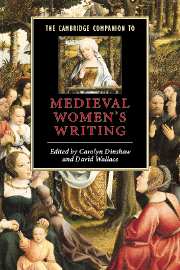Book contents
- Frontmatter
- Introduction
- Part I Estates of women
- Part II Texts and other spaces
- Part III Medieval women
- 10 Heloise
- 11 Marie de France
- 12 The Roman de la Rose, Christine de Pizan, and the querelle des femmes
- 13 Lyrics and romances
- 14 Julian of Norwich
- 15 Margery Kempe
- 16 Continental women mystics and English readers
- 17 Joan of Arc
- Further reading
- Index
10 - Heloise
from Part III - Medieval women
Published online by Cambridge University Press: 28 May 2006
- Frontmatter
- Introduction
- Part I Estates of women
- Part II Texts and other spaces
- Part III Medieval women
- 10 Heloise
- 11 Marie de France
- 12 The Roman de la Rose, Christine de Pizan, and the querelle des femmes
- 13 Lyrics and romances
- 14 Julian of Norwich
- 15 Margery Kempe
- 16 Continental women mystics and English readers
- 17 Joan of Arc
- Further reading
- Index
Summary
A visitor to the Cemetery of Pere Lachaise, east of Paris, may come across the canopied Gothic Revival tomb of Heloise and Abelard. They are a much visited couple in that crowded suburb of the dead - though less than Jim Morrison, less than Colette - and were among the first there, moved with the permission of Napoleon in 1804. For Père Lachaise was a commercial venture and needed some famous bodies to attract the monied corpses of the Second Empire. Thus was Heloise written into the emerging romance of capital.
It was not the first time Heloise had been cast into romance, not to speak of other genres, at the beck of masculine power. In her own youth she had heard herself written by Abelard into heartfelt lyrics of their passion, and in the early 1130s she encountered his narrative of the subsequent castration and fall from ecclesiastical pride, the Historia calamitatum. In the late 1270s Heloise was recast (in that part of the Romance of the Rose by Jean de Meun) as an instance of womanly virtue within an otherwise misogynist diatribe by a jealous husband;1 and later a treatise on courtly love was posthumously written under her (explicitly learned) authorship. Heloise’s own writings, however, record a profound and persistent will to choose her role, often in conflict with the men and institutional expectations around her, including Abelard, and their efforts to inscribe and circumscribe her. What she sometimes willed, and how she expressed that will in her letters, remain shocking.
- Type
- Chapter
- Information
- The Cambridge Companion to Medieval Women's Writing , pp. 161 - 171Publisher: Cambridge University PressPrint publication year: 2003



